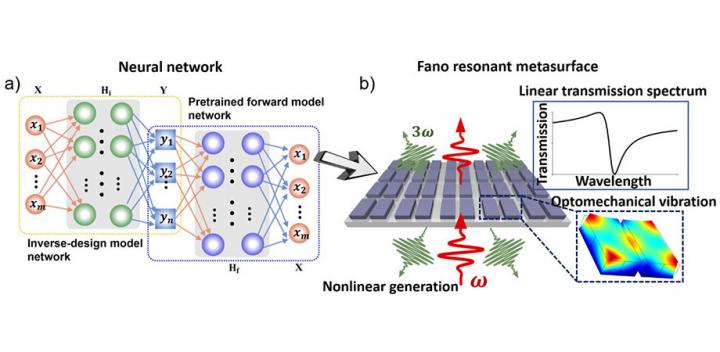The research is published in the SPIE-CLP journal Advanced Photonics

Credit: SPIE
BELLINGHAM, Washington, USA – A paper published in Advanced Photonics “Enhanced light-matter interactions in dielectric nanostructures via machine-learning approach,” suggests that machine-learning techniques can be used to enhance metasurfaces, optimizing them for nonlinear optics and optomechanics. The discovery has promising possibilities for the development of a wide range of photonic devices and applications including those involved in optical sensing, optoacoustic vibrations, and narrowband filtering.
Metasurfaces are versatile platforms used to manipulate the scattering, color, phase, or intensity of light that can be used for light emission, detection, modulation, control and/or amplification at the nanoscale. In recent years, metasurfaces have been a subject of undergoing intense study as their optical properties can be adapted to a diverse set of applications, including superlenses, tunable images, and holograms.
According to Advanced Photonics Co-Editor-in-Chief, SPIE Fellow, and Head of Photonics & Nanotechnology Group at King’s College London Anatoly Zayats, this work marks an exciting advancement in nanophotonics.
“Optimization of metasurfaces and metamaterials for particular applications is an important and time-consuming problem,” said Zayats. “With traditional approaches, only few parameters can be optimised, so that the resulting performance is better than for some other designs but not necessarily the best. Using machine learning, one can search for the best design and cover the space of parameters not possible with traditional approaches.”
###
The article authors are Lei Xu, Yixuan Ma, Fu Deng, Yan Kei Chiang, Lujun Huang, and Andrey E. Miroschnichenko, School of Engineering and Information Technology, The University of New South Wales, Canberra; Mohsen Rahmani, Daria A. Smirnova, Khosro Zangeneh Kamali, and Dragomir N. Neshev, Nonlinear Physics Centre, Research School of Physics, The Australian National University, Canberra; Haoyang Zhang, School of Electrical Engineering and Computer Science, Queensland University of Technology, Brisbane; and Stephen Gould, ANU College of Engineering and Computer Science, Queensland University of Technology, Brisbane.
Advanced Photonics, an open-access, peer-reviewed journal, is published by SPIE and Chinese Laser Press in the SPIE Digital Library, which contains more than 500,000 publications from SPIE journals, proceedings, and books, with approximately 18,000 new research papers added each year.
About SPIE
SPIE is the international society for optics and photonics, an educational not-for-profit organization founded in 1955 to advance light-based science, engineering, and technology. The Society serves more than 255,000 constituents from 183 countries, offering conferences and their published proceedings, continuing education, books, journals, and the SPIE Digital Library. In 2019, SPIE provided more than $5.6 million in community support including scholarships and awards, outreach and advocacy programs, travel grants, public policy, and educational resources. http://www.
Contact:
Daneet Steffens
Public Relations Manager
[email protected]
+1 360 685 5478
@SPIEtweets
Media Contact
Daneet Steffens
[email protected]
Original Source
https:/
Related Journal Article
http://dx.




